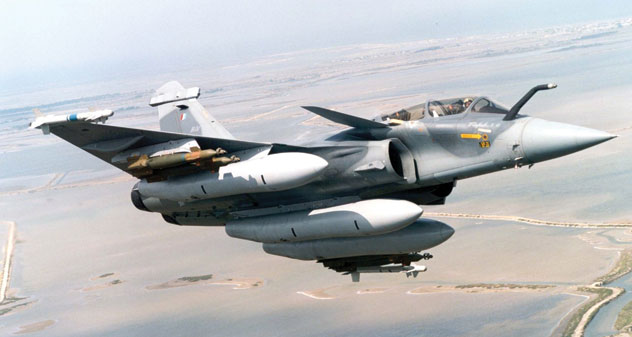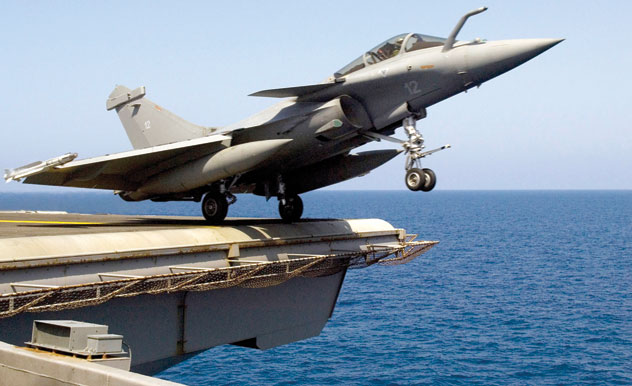SUBCONTINENT
Defence Upgrade: India Signs Mega Fighter Jet Deal
India’s military upgrade is driven by perceived security threats from Pakistan and China. Given an incipient domestic defense armament industry, India is importing most of its arms. After over a decade, India has finally decided on giving the multi-billion dollar contract to procure 126 combat aircrafts to French Rafale jets, making it one of the largest military aviation deals globally, writes Siddharth Srivastava.

(Above): The French-made Dassault Rafale combat aircraft in flight.
After over a decade in process, India has finally decided on the mother of defense deals -- the multi-billion dollar contract to procure 126 MMRCA (medium multi-role combat aircraft) French Rafale jets, one of the largest military aviation deals globally.
The value of the contract is not fully clear yet – it could be anywhere between U.S. $12-16 billion, though some estimates have pegged it at much larger U.S. $20 billion.
Welcoming the deal, French President Nicolas Sarkozy, in a statement, termed the deal “a vote of confidence in the entire French economy.”
From India’s point of view, depleted and outdated air strike capabilities needed an urgent infusion of fresh fighter jets.
Indian defense deals are notorious for their delays, corruption, indecision and red tape. However, a near emergency situation due to insufficient fighter jets, in the wake of potential security threats from neighbors like China and Pakistan, literally forced New Delhi to act on the matter.
Still, the contract is the first foreign deal for Dassault’s Rafale fighter jets and a major fillip to French armament industry. India’s decision could win Dassault more contracts, with the UAE a potential customer.
An offset component ensures a part of the money that India pays is re-invested in the country’s defense enterprise that remains rudimentary compared to global standards.
The competition was finally a toss up between the European Eurofighter Typhoon and the Rafale that the latter won after an exacting technical and commercial negotiation process. Recent successes in operations in Libya and Afghanistan also played a part in finally tilting the deal to the French jet.
It is also not lost to anybody that the Congress-led New Delhi government, facing major allegations of corruption, has settled for the cheapest aircraft to avoid any further controversy.

(Above): The French-made Dassault Rafale combat aircraft taking off from an aircraft carrier.
Eighteen fighter aircraft will now be delivered to India in “fly away” over the next three years while the remaining 108 will be indigenously built by state-owned Hindustan Aeronautics Ltd. via technology transfers.
Earlier in a bruising contest that also involved heavy doses diplomatic and strategic pressures, Russian MiG-35, Swedish Saab Gripen, the American Boeing F/A-18 and the Lockheed Martin F-16 combat jets were rejected on technical and operational grounds.
There were several reports than an unhappy Washington had been pushing New Delhi to re-consider the American aircrafts. The final choice was, however, expected this month as the money was already allotted in the annual budget (year ending March 2012) for the contract.
Leaving such a large capital outlay unutilized would have re-opened the charge of delay and indecision on New Delhi that was best avoided.
India has been looking to build a fighter jet fleet that will comprise the MMRCAs to replace the heavily crash prone Russian MiG-21 interceptors and fit air power between the more powerful long range Russian Sukhoi-30 and the lower-end indigenous Tejas LCA lightweight fighters.
While the Sukhois are a guard against China, the Rafales will be deployed mostly to take on Pakistan, if needed. The Rafale contract in turn forms part of India’s estimated U.S. $100 billion import-driven defense modernization exercise spread over a decade that comprises submarines, tanks, missiles, aircraft carriers, advanced radars, artillery gun and more.
India’s military upgrade is driven by perceived security threats from Pakistan and China. Given an incipient domestic defense armament industry, India is importing most of the arms it needs.
According to the Swedish think tank Stockholm International Peace Research Institute, India was the world’s biggest importer of arms between 2006 and 2010 accounting for 9% of the global arms trade in the period.
Pakistan and China, two countries with which India has fought wars in the past, on their part do not lag defense efforts in any way.
Pakistan continues to receive military largess from America as a partner in the global war against terror, though India has for long held that such stock piling of weapons only add to instability in the region.
New Delhi feels that U.S.-supplied armaments to Pakistan are more potent against a conventional enemy rather than the amorphous terror networks that also spread over Afghanistan and need effective intelligence and pin-pointed operations, such as the one that killed Osama Bin Laden, to neutralize.
Pakistan’s military, meanwhile continues to be supported by Beijing with several of its attack ballistic missiles with a potential to destroy Indian cities a copy of those in possession of China.
China’s military prowess, of course, continues to be far ahead of India. The country has managed to blatantly copy western arms prototypes to build effective domestic armament manufacturing capability that has reduced its arms imports dependence that is reflected in the statistics over the past few years.
Given the closed nature of China’s polity, nobody is quite sure about the kind of investments and developments that are happening in China’s defense sphere. Some analysts believe that China’s military capabilities today could be superior to America.
Given such a scenario India has no choice but to build an effective deterrence against China while matching the military capabilities of Pakistan, against whom the security threats are more immediate.
India is also making a conscious effort to move away from dependence on imports from Russia to countries such as Israel and America, apart from deepening ties with traditional partners such as France, Sweden and Britain.
The Russian defense industry is seen as increasingly outdated in the absence of effective State support. Existing Russian defense platforms in India’s possession are depleted due to lack of spare parts and post sale maintenance.
Washington has been using every diplomatic and strategic means to pressure India to buy weapons from American firms. India has already signed multi-billion dollar defense contracts with America comprising transport and reconnaissance aircrafts and this process is only going to grow in the future.
|